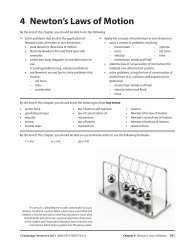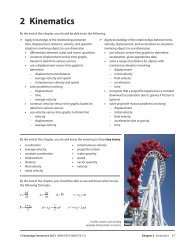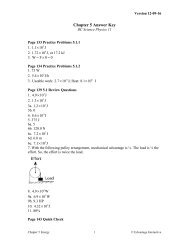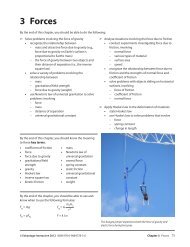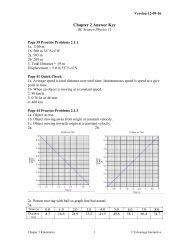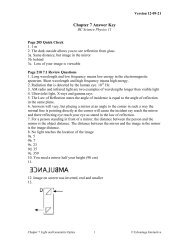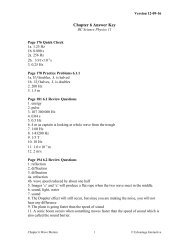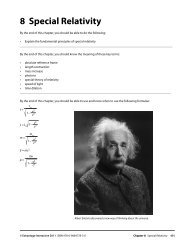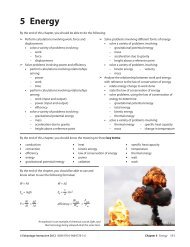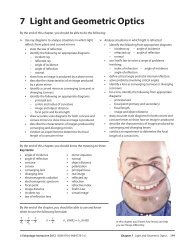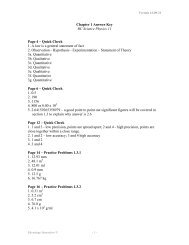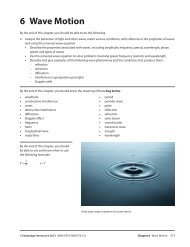Draft BCPhysics11-4 Edvantage Interactive.pdf - BC Science ...
Draft BCPhysics11-4 Edvantage Interactive.pdf - BC Science ...
Draft BCPhysics11-4 Edvantage Interactive.pdf - BC Science ...
You also want an ePaper? Increase the reach of your titles
YUMPU automatically turns print PDFs into web optimized ePapers that Google loves.
Measuring Inertia<br />
Quick Check<br />
As a general rule, any object tends to continue moving with whatever speed and<br />
direction it already has. This can include zero speed. When a driver accelerates a car, a<br />
body in the car tends to keep doing what it was already doing. So if the car is stopped,<br />
you are stopped. As the car starts to move and speeds up, you feel as if you are being<br />
pushed back into your seat.<br />
The tendency that all objects have to resist change in their states of motion is called<br />
inertia. Every object in the universe that has mass has this property of inertia. Galileo<br />
Galilei (1564–1642) was the first person to describe this property of nature, which is called<br />
the law of inertia.<br />
Some objects have more inertia than others because they have more mass. A<br />
logging truck has much more inertia than a mountain bike. Because it has so much more<br />
inertia, the logging truck is<br />
(a) more difficult to get moving<br />
(b) more difficult to stop<br />
(c) more difficult to turn at a corner<br />
Is there a way to measure inertia? You have measured it many times in science class. The<br />
way to measure inertia is to measure the object’s mass. When you measure the mass of an<br />
object using a balance, that mass is equal to the object’s inertial mass.<br />
Strictly speaking, what the balance measures is called gravitational mass. This<br />
is because the unknown object is placed on one pan, and a standard mass is placed on<br />
the other pan. The masses are assumed to be equal when the force of gravity on the<br />
unknown mass balances the force of gravity on the standard mass. Gravitational mass is<br />
numerically equal to inertial mass, so a balance can be used to measure inertial mass as<br />
well.<br />
1. Why does it hurt more to kick a rock shaped like a soccer ball than a soccer ball?<br />
_________________________________________________________________________________________<br />
_________________________________________________________________________________________<br />
2. When astronauts are living in the International Space Station (ISS) they are in orbit around Earth at a<br />
minimum altitude of 278 km. They live in an environment of apparent weightlessness. Compare the inertial<br />
mass of the astronauts when they live on the ISS and to their inertial mass when they are on Earth.<br />
_________________________________________________________________________________________<br />
_________________________________________________________________________________________<br />
Newton’s First Law<br />
Isaac Newton (1642–1727) is considered one of the greatest scientists of all time. In<br />
any physics class you ever take, you will come across his name at some time. This is<br />
impressive, given that all his work was done more than 350 years ago. Newton is probably<br />
best known for his laws of motion. Newton’s three laws describe motion as we experience<br />
it on Earth. They are also the foundation for helping to send humans to the Moon and<br />
deep-space vehicles out beyond our solar system.<br />
© <strong>Edvantage</strong> <strong>Interactive</strong> 2011 ISBN 978-0-9864778-3-6 Chapter 4 Newton’s Laws of Motion — DRAFT 163



